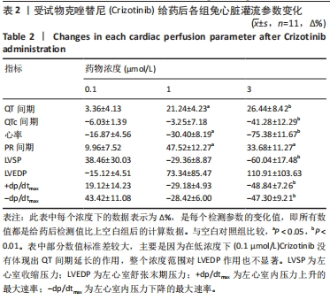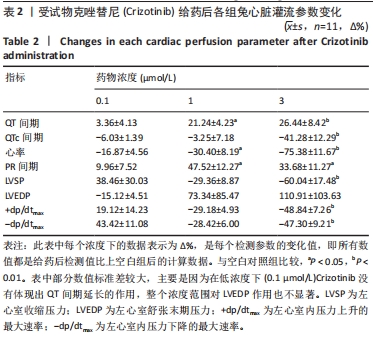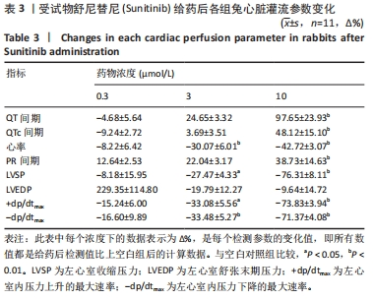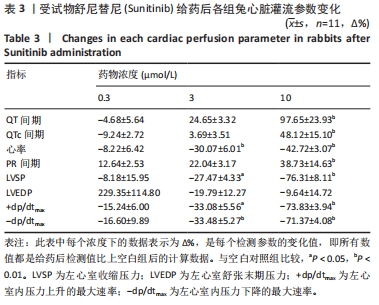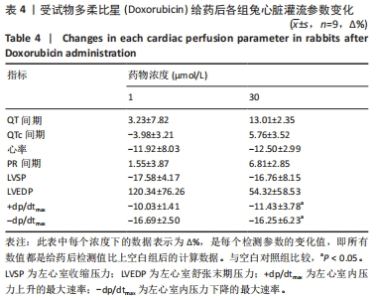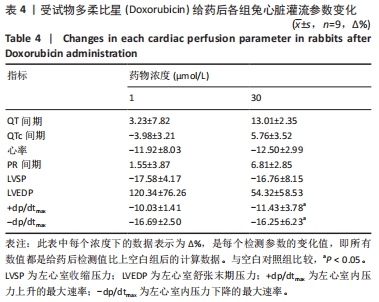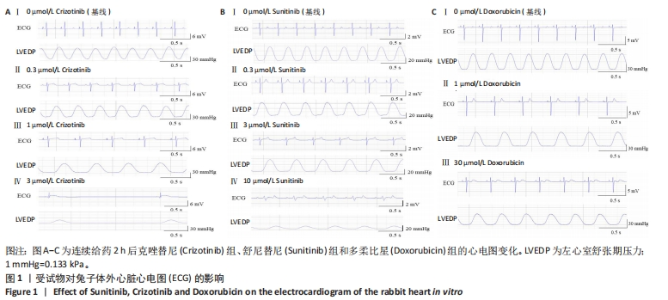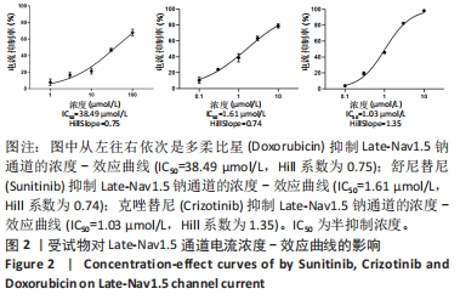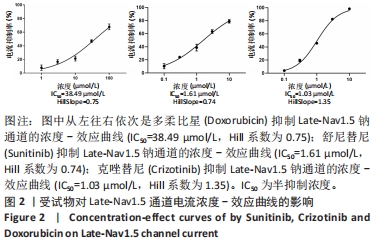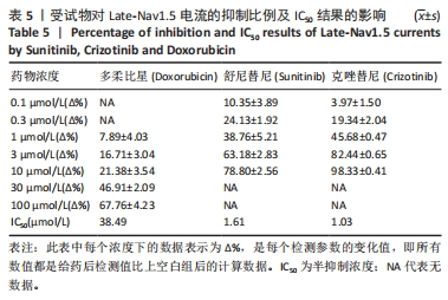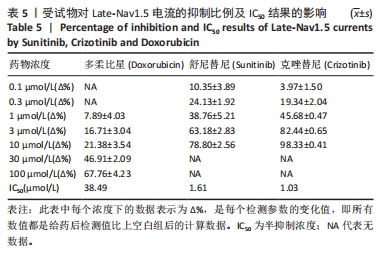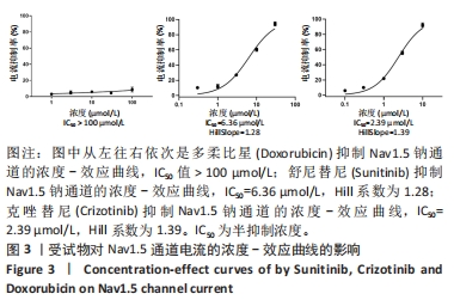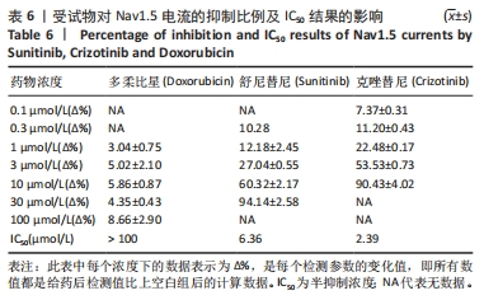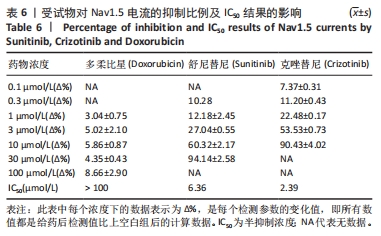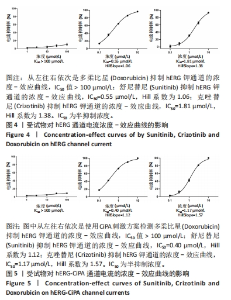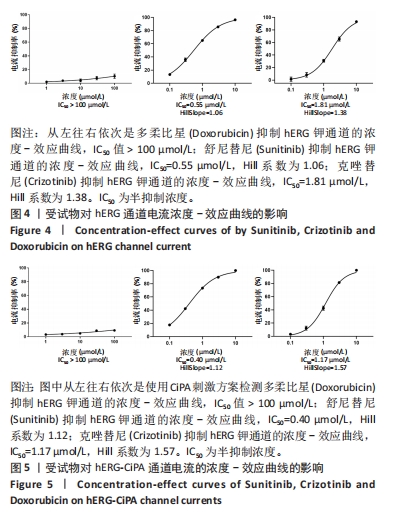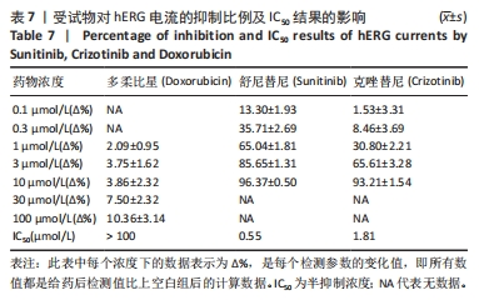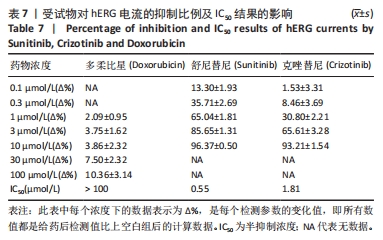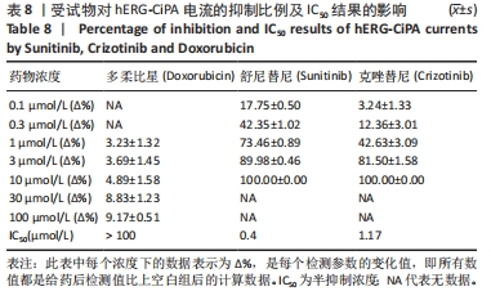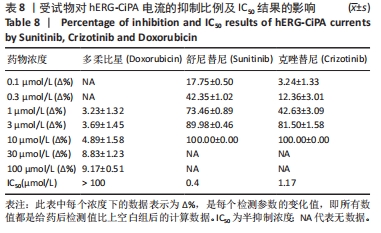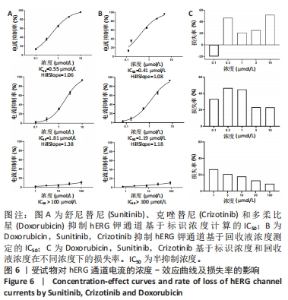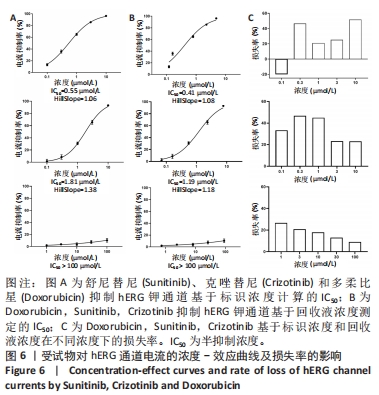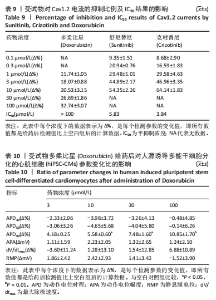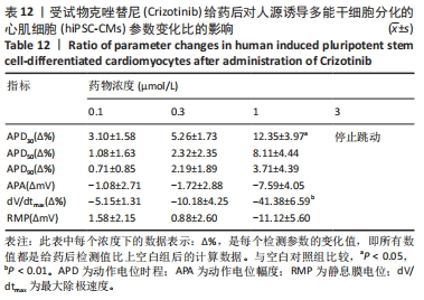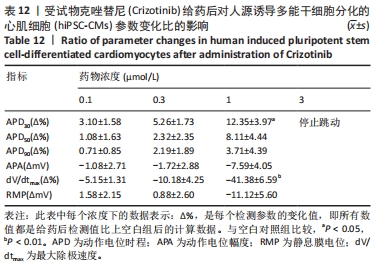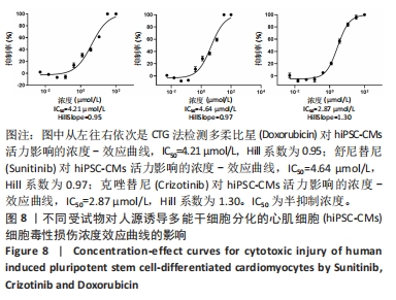Chinese Journal of Tissue Engineering Research ›› 2024, Vol. 28 ›› Issue (27): 4265-4272.doi: 10.12307/2024.560
Safety risk assessment of in vitro heart in antitumor drug development
Zheng Shuangjia, Zhao Ting, Ren Cuixia, Wang Baoqiang, Chen Lanlan, Lin Moxu, Li Yingji, Zhang Xu
- Neurocardiology Center, Ice-Biosci, Beijing 100000, China
-
Received:2023-09-12Accepted:2023-11-08Online:2024-09-28Published:2024-01-26 -
Contact:Zhang Xu, MD, Neurocardiology Center, Ice-Biosci, Beijing 100000, China -
About author:Zheng Shuangjia, Master, Neurocardiology Center, Ice-Biosci, Beijing 100000, China -
Supported by:Beijing Municipal Science and Technology Commission Science and Technology Program, No. Z211100002521003 (to LYJ)
CLC Number:
Cite this article
Zheng Shuangjia, Zhao Ting, Ren Cuixia, Wang Baoqiang, Chen Lanlan, Lin Moxu, Li Yingji, Zhang Xu. Safety risk assessment of in vitro heart in antitumor drug development[J]. Chinese Journal of Tissue Engineering Research, 2024, 28(27): 4265-4272.
share this article
Add to citation manager EndNote|Reference Manager|ProCite|BibTeX|RefWorks

图7为受试物对Cav1.2通道电流的浓度-效应曲线。表9结果显示,Doxorubicin在100 μmol/L下抑制率为(32.74±3.07)%,在测试浓度范围内IC50值为> 100 μmol/L;Sunitinib在10 μmol/L时抑制率超过50%,IC50值为5.83 μmol/L;Crizotinib在10 μmol/L时抑制率超过50%,IC50值为3.84 μmol/L。 2.3.2 受试物对hiPSC-CMs动作电位的影响 表10结果显示,Doxorubicin在测试浓度范围内对hiPSC-CMs的动作电位时程APD90延长(10.85±1.70)%,对APD30和APD50无明显变化,同时,对hiPSC-CMs动作电位的幅度(APA)和静息电位(RMP)也无明显变化。"
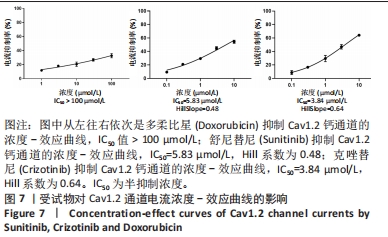
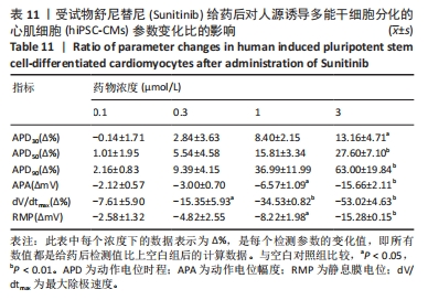
表11结果显示,Sunitinib一定程度延长了hiPSC-CMs动作电位时程,在1 μmol/L浓度下,对APD90延长(36.99±11.99)%,在3 μmol/L浓度下,对APD90延长(63.00±19.84)%,同时减小了hiPSC-CMs动作电位的幅度APA(-15.66±2.11)%和心肌细胞的静息电位RMP(-15.28±0.15)%,并减缓了细胞动作电位最大除极速度dV/dtmax (-53.02±4.63)%,差异均有显著性意义(P < 0.05),结合离子通道检测结果1 μmol/L和3 μmol/L浓度超过了APD90风险阈值(10%-15%)[13-16],有致心律失常的风险。"
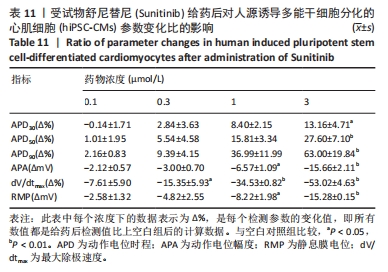
| [1] 司丹妮,李彩娥,陈馨嵘,等.酪氨酸激酶抑制剂诱导的心脏毒性发病情况、评估和监测研究进展[J]. 山东医药,2022,62(33):97-102. [2] SELTZER JH, GINTANT G, AMIRI-KORDESTANI L, et al. Assessing cardiac safety in oncology drug development. Am Heart J. 2019;214:125. [3] SHYAM SUNDER S, SHARMA UC, POKHAREL S. Adverse effects of tyrosine kinase inhibitors in cancer therapy: pathophysiology, mechanisms and clinical management. Signal Transduct Target Ther. 2023;8(1):262 [4] WANG H, WANG Y, LI J, et al. Three tyrosine kinase inhibitors cause cardiotoxicity by inducing endoplasmic reticulum stress and inflammation in cardiomyocytes. BMC Med. 2023;21(1):147 [5] KADDOURA R, DABDOOB WA, AHMED K, et al. A practical guide to managing cardiopulmonary toxicities of tyrosine kinase inhibitors in chronic myeloid leukemia. Front Med (Lausanne). 2023;10:1163137. [6] YAMAMICHI Y, KUSUOKA H, MORISHITA K, et al. Metabolism of iodine-123-BMIPP in perfused rat hearts. J Nucl Med. 1995;36(6):1043-1050. [7] RUMSEY WL, PATEL B, LINDER KE. Effect of graded hypoxia on retention of technetium-99m-nitroheterocycle in perfused rat heart. J Nucl Med. 1995;36(4): 632-636. [8] KUBURAS R, GHARANEI M, HAUSSMANN I, et al. Metformin protects against sunitinib-induced cardiotoxicity: investigating the role of AMPK. J Cardiovasc Pharmacol. 2022;79(6):799-807. [9] OBEJERO-PAZ CA, BRUENING-WRIGHT A, KRAMER J, et al. Quantitative profiling of the effects of vanoxerine on human cardiac ion channels and its application to cardiac risk. Sci Rep. 2015;5:17623. [10] JONSSON MK, DUKER G, TROPP C, et al. Quantified proarrhythmic potential of selected human embryonic stem cell-derived cardiomyocytes. Stem Cell Res. 2010;4(3):189-200. [11] GILLIE DJ, NOVICK SJ, DONOVAN BT, et al. Development of a high-throughput electrophysiological assay for the human ether-à-go-go related potassium channel hERG. J Pharmacol Toxicol Methods. 2013;67(1):33-44. [12] COHEN JD, BABIARZ JE, ABRAMS RM, et al. Use of human stem cell derived cardiomyocytes to examine sunitinib mediated cardiotoxicity and electrophysiological alterations. Toxicol Appl Pharmacol. 2011;257(1):74-83. [13] WHITMIRE ML, BRYAN P, HENRY TR, et al. Nonclinical dose formulation analysis method validation and sample analysis. AAPS J. 2010;12:628-634. [14] ROCHE O, TRUBE G, ZUEGGE J, et al. A virtual screening method for prediction of the hERG potassium channel liability of compound libraries. Chembiochem. 2002;3(5):455-459. [15] GINTANT GA, LIMBERIS JT, MCDERMOTT JS, et al. The canine Purkinje fiber: an in vitro model system for acquired long QT syndrome and drug-induced arrhythmogenesis. J Cardiovasc Pharmacol. 2001;37(5):607-618. [16] TAKASUNA K, KATSUYOSHI C, MANABE S. Pre-clinical QT risk assessment in pharmaceutical companies-issues of current QT risk assessment. Biomol Ther. 2009;17(1):1-11. [17] SHARMA A, BURRIDGE PW, MCKEITHAN WL, et al. High-throughput screening of tyrosine kinase inhibitor cardiotoxicity with human induced pluripotent stem cells. Sci Transl Med. 2017;9(377):eaaf2584. [18] NAZEYROLLAS P, PREVOST A, BACCARD N, et al. Effects of amifostine on perfused isolated rat heart and on acute doxorubicin-induced cardiotoxicity. Cancer Chemother Pharmacol. 1999;43:227-232. [19] TOKARSKA-SCHLATTNER M, ZAUGG M, DA SILVA R, et al. Acute toxicity of doxorubicin on isolated perfused heart:response of kinases regulating energy supply. Am J Physiol Heart Circ Physiol. 2005;289:H37-H47. [20] WANG YX, KORTH M. Effects of doxorubicin on excitation-concentration coupling in guinea pig ventricular myocardium. Circ Res. 1995;76:645-653. [21] STEINBERG JS, COHEN AJ, WASSERMAN AG, et al. Acute arrhythmogenicity of doxorubicin administration. Cancer. 1987;60:1213-1218. [22] DUCROQ J, MOHA OU MAATI H, GUILBOT S, et al. Dexrazoxane protects the heart from acute doxorubicin-induced QT prolongation: a key role for IKs. Br J Pharmacol. 2010;159:93-101. [23] FAIVRE S, DELBALDO C, VERA K, et al. Safety, pharmacokinetic, and antitumor activity of SU11248, a novel oral multitarget tyrosine kinase inhibitor, in patients with cancer. J Clin Oncol. 2006;24(1):25-35. [24] KHOSRAVAN R, TOH M, LAFARGUE J, et al. Sunitinib pharmokinetic (PK) and safety data in subejcts with renal impairment and hemodialysis. 2008. [25] CHU TF, RUPNICK MA, KERKELA R, et al. Cardiotoxicity associated with tyrosine kinase inhibitor sunitinib. Lancet. 2007;370:2011-2019. [26] DI LORENZO G, AUTORINO R, BRUNI G, et al. Cardiovascular toxicity following sunitinib therapy in metastatic renal cell carcinoma: a multicenter analysis. Ann Oncol. 2009;20:1535-1542. [27] COHEN JD, BABIARZ JE, ABRAMS RM, et al. Use of human stem cell derived cardiomyocytes to examine sunitinib mediated cardiotoxicity and electrophysiological alterations. Toxicol Appl Pharmacol. 2011;257(1):74-83. [28] OBRIEN Z, F MOGHADDAM M. A systematic analysis of physicochemical and ADME properties of all small molecule kinase inhibitors approved by US FDA from January 2001 to October 2015. Curr Med Chem. 2017;24(29):3159-3184. [29] KURATA Y, MIYAUCHI N, SUNO M, et al. Correlation of plasma crizotinib trough concentration with adverse events in patients with anaplastic lymphoma kinase positive non-small-cell lung cancer. J Pharm Health Care Sci. 2015;1(1):1-5. [30] LESTER RM. Update on ICH E14/S7B cardiac safety regulations: the expanded role of preclinical assays and the “double-negative” scenario. Clin Pharmacol Drug Dev. 2021;10(9):964-973. [31] CURIGLIANO G, SPITALERI G, DE BRAUD F, et al. QTc prolongation assessment in anticancer drug development: clinical and methodological issues. Ecancermedicalscience. 2009;3:130. [32] PANG L, SAGER P, YANG X, et al. Workshop report: FDA workshop on improving cardiotoxicity assessment with human-relevant platforms. Circ Res. 2019;125(9):855-867. [33] SHARMA A, BURRIDGE PW, MCKEITHAN WL, et al. High-throughput screening of tyrosine kinase inhibitor cardiotoxicity with human induced pluripotent stem cells. Sci Transl Med. 2017;9(377):eaaf2584. [34] SELTZER JH, GINTANT G, AMIRI-KORDESTANI L, et al. Assessing cardiac safety in oncology drug development. Am Heart J. 2019;214:125-133. [35] XIAO L, SALEM JE, CLAUSS S, et al. Ibrutinib-mediated atrial fibrillation attributable to inhibition of C-Terminal Src kinase. Circulation. 2020;142(25):2443-2455. |
| [1] | Zhang Boya, Duan Hongmei, Bai Tianyu, Hao Fei, Hao Peng, Zhao Wen, Gao Yudan, Li Xiaoguang, Yang Zhaoyang. Neurotrophic factor 3-chitosan carrier induces neural stem cells to differentiate into neuronal subtypes and their electrophysiological properties [J]. Chinese Journal of Tissue Engineering Research, 2023, 27(25): 4020-4027. |
| [2] | Zhang Xin, Lu Ying, Yao Qingqiang, Zhu Yishen. Preparation and in vitro evaluation of self-assembling peptide hydrogel loaded with doxorubicin [J]. Chinese Journal of Tissue Engineering Research, 2021, 25(16): 2488-2493. |
| [3] | Su Liping, Liu Li, Lu Ziyang, Su Tianyuan, Hu Xiayun, Pu Hongwei. Diethylmorphine effect on action potential and calcium ion current of neonatal rat cardiomyocytes in vitro [J]. Chinese Journal of Tissue Engineering Research, 2020, 24(26): 4201-4207. |
| [4] | Zhang Wenjing, Wang Jia, Tian Mengting, Han Xiangzhen, Zhou Qiqi, He Huiyu. Effects of bone morphogenetic protein 2 and basic fibroblast growth factor 2 on proliferation and osteogenic differentiation of rat bone marrow mesenchymal stem cell sheet [J]. Chinese Journal of Tissue Engineering Research, 2020, 24(1): 65-71. |
| [5] | Li Yongheng, Cui Yan, Zhang Zhiyu. Inhibitory effects of doxorubicin-loaded chitosan nanoparticles on osteosarcoma in mice [J]. Chinese Journal of Tissue Engineering Research, 2019, 23(26): 4194-4199. |
| [6] |
Xing Li-na, Zhang Xue-jun, Wang Ying, Niu Zhi-yun, Wang Fu-xu, Wen Shu-peng.
Graphene oxide loaded with doxorubicin: a killer for multiple myeloma cells
[J]. Chinese Journal of Tissue Engineering Research, 2016, 20(38): 5636-5641.
|
| [7] | Yang Huan-dan, Zhang Rui-feng, Feng Dong-jin, Zhu Bing-bing, Lv Juan . Effects of bone marrow mesenchymal stem cell transplantation on CD4+CD25+ regulatory T cells in rats with primary nephrotic syndrome [J]. Chinese Journal of Tissue Engineering Research, 2014, 18(1): 33-38. |
| [8] | Wang Dan, Jiang Hang-hang. Characteristics and experimental application of polylactic acid copolymer composite sustained-release drug materials [J]. Chinese Journal of Tissue Engineering Research, 2013, 17(8): 1473-1480. |
| [9] | Wang Qiang, He Jin-shan, Xiong Chuan-zhi, Feng Xin-min, Wang Jing-cheng, Yan Lian-qi, Chen Peng-tao, Cai Jun. Effects of the L-type calcium channels on chondrocytes in response to basic fibroblast growth factor [J]. Chinese Journal of Tissue Engineering Research, 2013, 17(50): 8654-8659. |
| [10] | Qu Shao-zheng, Li Shu-zhong, Gao Jia-ke, Zhang Jin-feng. Isolation and identification of osteosarcoma stem cells [J]. Chinese Journal of Tissue Engineering Research, 2013, 17(14): 2641-2648. |
| Viewed | ||||||
|
Full text |
|
|||||
|
Abstract |
|
|||||
